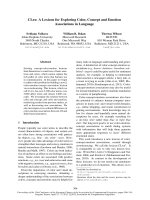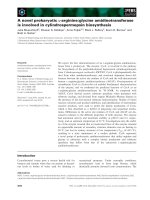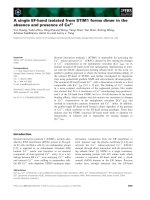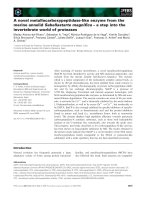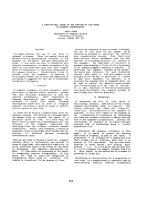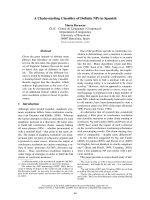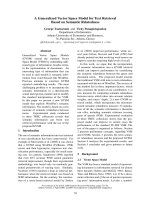Báo cáo khoa học: "A canine distemper virus isolated from an autopsied dog in Hanoi, Vietnam" pot
Bạn đang xem bản rút gọn của tài liệu. Xem và tải ngay bản đầy đủ của tài liệu tại đây (239.25 KB, 5 trang )
Journal of Science and Development April 2008: 70-74 HANOI UNIVERSITY OF AGRICULTURE
A canine distemper virus isolated from an autopsied dog
in Hanoi, Vietnam
Nguyen Thi Lan
*
, Yamaguchi Ryoji
**
, Nguyen Huu Nam
*
, Trần Trung Kiên
*
*
Faculty of Veterinary Medicine (FVM), Ha noi University of Agriculture (HUA)
**
Department of Veterinary Phathology, Faculty of Agriculture, University of Miyazaki, Miyazaki 889-2192, Japan
Abstract
The fresh samples of lung taken post mortem from an autopsied dog with evidence of
canine distemper was used for isolation of canine distemper virus (CDV). The lung of the dog
was congested by hemorrhagic and pneumonic, with much fluid or exudate. Severe interstitial
pneumonia was found with some eosinophilic cytoplasmic inclusion bodies in alveolar
epithelium, and CDV antigens strongly positive among alveoli. The CDV was isolated by using
Vero cells with CDV receptor and was confirmed by RT-PCR of the 429 bp fragment P gene. The
isolated strain CDV-HN1 had the titer of 3.16x10
5
TCID
50
/ 25 μl. The results indicated that the dog
population in Hanoi was infected with CDV.
Key words: Canine distemper; dog; isolation; Hanoi, Vietnam.
1. INTRODUCTION
Canine distemper disease is a fatal disease
in dogs, ferrets and wild carnivores cause by
Canine distemper virus (CDV). The first target
of CDV is lymphoid tissues, causing
immunosuppression, later the virus spreads to
epithelial and nervous tissues respectively.
CDV is a member of genus Mobillivirus in the
Paramyxoviridae family and closely related to
measle virus and Phocine distemper virus
(PDV). The Mobillivirus is composed of 6
protein genes. Fusion (F) and Hemagglutinin
(H) glycoprotein are envelope proteins. H
protein is a receptor binding site and F protein
induces the fusion between viral envelope and
host cell membrane. Nucleocapsid protein (N),
Phosphoprotein (P) and Large protein (L) are a
nucleocapsid core, cooperating in viral
replication. Matrix (M) protein assembles
between the envelope proteins and the
nucleocapsid core (Griffin and Bellini, 1996).
CDV can be isolated by using co-
cultivation of lymphocytes from SPF dogs with
mitogen-stimulated canine lymphocytes (Appel
et al., 1992) or ferret peritoneal macrophages
from SPF ferrets (Poste et al., 1971; Whetstone
et al., 1981). MDCK (Canine epithelial kidney)
cells were used to isolate CDV from clinical
samples successfully but the development of
CPE was delayed (Lednicky et al., 2004). B95a
cells derived from marmoset B lymphoblastoid
cell line were susceptible to CDV (Kai et al.,
1993). Field isolates are not propagated easily
in Vero cells derived from African green
monkey kidney cells (Appel et al., 1992). In
Vero cells, no virus was isolated from dogs
(Seki et al., 2003). It was shown that Vero cells
with CDV receptor were established and very
sensitive for isolation of wild CDV strains
compared to B95a cells (Seki et al., 2003). So
far, we believe no reports exist of CDV in
Vietnam. Therefore, in this study, we reported
the pathological findings of a distemper dog
and isolated the CDV from this autopsied dog
in Hanoi, Vietnam. After isolation of virus, we
will examine the characteristics of virus for
futher purposes and further molecular and
vaccine studies.
70
A canine distemper virus isolated from an autopsied dog in Hanoi, Vietnam
2. MATERIALS AND METHODS
Samples
Tissues of lung, pulmonary lymph nodes,
cerebellum, cerebrum and brain sterm selected
for this study were collected at necropsy from a
three month-dog having the pathological
changes consistent with canine distemper,
supported by the immunohistochemical
demonstration of CDV antigens. These tissues
were stored at -80
0
C.
Cell lines and cultures
Vero cells with CDV receptor generated by
transfecting Vero cells with pCXN2 and
pCAGDogSLAMtag (DST) (Seki et al., 2003)
supplied by Kuyshu University. They were
grown in DMEM with 10% FCS, 10% sodium
carbonate, 100 units/ml of penicillin and
100μg/ml of streptomycin and 0.4 mg of
geneticin (G418) per ml in incubator at 37
0
C
under 5% CO
2
.
Pathological examination and
immunohistochemistry
After necropsy, samples were fixed with
10% formalin and were embedded in paraffin
wax. Sections (4 μm) were cut and stained with
haematoxylin and eosin. Immunohistochemistry
was done by using a mouse monoclonal
antibody specific for CDV-nucleoprotein and
an Envision polymer reagent (DAKO
Corporation, USA) as described previously
(Kumagai et al., 2004).
Virus isolation
The homogenized and sonicated fresh
sample of lung treated to obtain only virus
suspension was inoculated into petri-dishes
seeded with Vero cells with CDV receptor.
After adsorption for 30 min, the cells were
incubated in 5% CO
2
at 37
0
C. CPEs were daily
observed by phase contrast microscope.
Virus titration
Virus titration was performed with 50%
tissue culture infectious dose (TCID
50
) assay.
Sample of CDV isolated from lung tissue in
Vero cells with CDV receptor were serially
diluted in 10 fold steps. Twenty-five μl of each
dilution was inoculated into each of 3 wells of
96 well plates with Vero-DST cells
(Yamaguchi et al., 1988). TCID
50
was
calculated by the method of Behres- Karber.
Reverse transcription reaction (RT-PCR)
Total RNA was extracted from CDV -
infected Vero cells with CDV receptor by using
Trizol reagent (Invitrogen) according to the
manufacture's instructions. A mixture of 1 μl
(150 ng/μl) of random hexanucleotide primers,
5 μl of RNA and 4 μl of DEPC treated water
was denatured at 70
0
C for 5 min and incubated
at room temperature for 10 min. The cDNA was
synthesized in 20 μl of reaction mixture
containing 10 μl of annealed RNA-random
hexamer mixture, 2.5 μl of DEPC treated water,
4 μl of RT buffer, 2 μl of 0.1M DTT, 1 μl of
10mM dNTP (dATP, dCTP, dGTP, dTTP) and
0.5 μl of reverse transcriptase (Superscript II)
(Invitrogen). Reverse transcription reaction was
performed at room temperature for 5 min and
37
0
C for 40 min. Primer set used for
polymerase chain reaction (RT-PCR) was upp1
and upp2 (Lan et al., 2005). cDNA of
Onderstepoort strain propagated in Vero-DST
cells was the positive control, and mixture
without the matrix was the negative control of
the reaction. The electrophoresis of 10 μl of
PCR products was performed in a 1.2% agarose
gel. The size of amplicons was compared with a
100bp DNA ladder.
3. RESULTS
Pathological findings
The necropsied dog had a history of
coughing, nasal, ocular discharge and
emeciation.
The lung was congested by hemorrhage
and pneumonia, with much fluid or exudate
(Fig. 1). Lung section showed severe
interstitial pneumonia with some eosinophilic
cytoplasmic inclusion bodies in alveolar
71
Nguyen Thi Lan, Yamaguchi Ryoji, Nguyen Huu Nam, Tran Trung Kien
epithelium. CDV antigens strongly positive
among alveoli (Fig. 2a,b).
Lymph nodes were grossly enlarged.
Microscopically, lymph nodes showed
lymphoid depletion of the tissue or necrosis.
The intestine showed enteritis with eosinophilic
intracellular inclusion bodies in the intestinal
crypts and gastric glands. CDV antigens were
strongly positive in epithelial cells detected by
immunohistochemistry. No significant lesions
were observed in the nervous system.
Fig. 1. The lung of autopsied dog was congested by hemorrhage with pneumonia.
Fig. 2. The histopathological findings of the canine lung. Severe interstitial pneumonia was found with
some eosinophilic cytoplasmic inclusion bodies in alveolar epithelium (a) (x40); CDV antigens (shown
by brown color) were strongly positive among alveoli (b) (x 10).
Isolation and titration of new isolates
The samples collected from the lung of the
autopsied dog were inoculated into Vero cells
with CDV receptor. CPE characterized by
syncytium formation occurred from 24 hpi. The
number and size of syncytia were increased
gradually (Fig. 3) The isolated CDV was
confirmed by RT-PCR with the 429 bp fragment
P gene and immunocytochemistry (Figure 4) and
called CDV-HN1. CDV in fresh sample of lung
was also checked by RT-PCR.
After successful isolation in Vero cells
with CDV receptor, the titers of strain CDV-
HN1 were checked by TCID
50
with same cell
line. The titer of strain CDV-HN1 was
3.16x10
5
TCID
50
/ 25 μl.
72
A canine distemper virus isolated from an autopsied dog in Hanoi, Vietnam
Fig. 3. CPE caused by CDV in Vero cells with
CDV receptor was characterized by syncytium
formation and occurred at 24 hpi.
Fig. 4. The isolated CDV was detected by RT-
PCR of the 429 bp fragment P gene. Lane M:
100bp DNA Marker; Lane 1: Fresh sample of
lung used for RT-PCR; Lane 2: Sample from
Vero cells with CDV receptor infected with CDV
showing CPE.
4. DISCUSSION
These results confirmed that Vero cells
with CDV receptor were extremely efficient for
isolation of CDV from clinical samples
compared to Vero cells. Mitogen stimulated
canine lymphocytes was effective for isolation
of CDV from field cases (Appel et al., 1992).
However, it is not easy to get lymphocytes from
SPF dogs. Recently, B95a cells (Kai et al.,
1993) and MDCK cells (Lednicky et al., 2004)
have been using for isolation of CDV
successfully. However, the isolation rate was
low and the development of CPE required a
long time. Two amino acids in H protein of the
viruses isolated from this cell line are different
from those of the isolated viruses from Vero-
DST cells (Seki et al., 2003).
It was reported that CDV could be titrated
by plaque forming unit (PFU) in Vero cells
(Johnson et al., 1985). We tried to titrate new
isolates in Vero cells and Vero-DST cells.
Plaques were not produced in Vero cells. In
contrast, large, untidy plaques were formed in
Vero-DST cells and could not be counted. The
adherent nature of Vero-DST cells is probably
too sensitive for forming syncytia. In Vero-DST
cells, we could not only isolate CDV but also
identify the titer of virus from clinical samples
easily.
Recently, there are two groups of CDV
circulating in Asia (Lan et al., 2006). However,
in order to understand which group that the
CDV-HN1 strain belongs to, the molecular
characteristics of the virus should be done in
the further study.
In conclusion, the results of present study
indicated that CDV was circulating in the dogs
in Hanoi, Vietnam.
73
Nguyen Thi Lan, Yamaguchi Ryoji, Nguyen Huu Nam, Tran Trung Kien
REFERENCES
Appel, M.J., Pearce-Kelling, S. and Summers
B.A., (1992). Dog lymphocyte cultures
facilitate the isolation and growth of
virulent canine distemper virus. J. Vet.
Diagn. Invest. 4:258-263.
Griffin, D.E., Bellini, W.J., (1996). Measles
virus. In: Fields, B.N., Knipe, D.M.,
Howley, P.M. (Eds.), Fields virology,
third ed. Lippincott - Raven Publishers,
Philadelphia, pp. 1267-1296.
Johnson,G.C., Fulks, K. and Krakowka, S.,
(1985). Plaque identification of strand-
forming canine distemper virus by
staphylococcal protein A-mediated
reverse passive haemadsorption. Journal
of Virological Methods,10, 127-134.
Kai, C., Ochikubo, F., Okita, M., Iinuma, T.,
Mikami, T., Kobune, F. and
Yamanouchi, K., (1993). Use of B95a
cells for isolation of canine distemper
virus from clinical cases. J. Vet. Med.
Sci. 55: 1067-1070.
Kumagai, K., Yamaguchi, R., Uchida, K. and
Tateyama, S., (2004). Lymphoid
apoptosis in acute canine distemper. J.
Vet. Med. Sci. 66, 175-181.
Lan, N. T., Yamaguchi, R., Uchida, K., Sugano,
S. and Tateyama, S., (2005). Growth
Profiles of Recent Canine Distemper
Isolates on Vero Cells Expressing Canine
Signalling Lymphocyte Activation
Molecule (SLAM). J. Comp. Pathol. 133,
77-81.
Lan, N.T., Yamaguchi, R., A. Kawabata,
K.Uchida, S. Sugano, and Tateyama, S.,
(2006). Comparison of molecular
analysis and growth properties of two
different clusters of canine distemper
viruses recently isolated in Japan. J. Vet.
Med. Sci. (in press)
Lednicky, J.A., Meehan, T.P., Kinsel, M.J.,
Dubach, J., Hungerford, L.L., Sarich,
N.A., Witecki, K.E., Braid, M.D.,
Pedrak, C. and Houde, C.M., (2004).
Effective primary isolation of wild-type
Canine distemper virus in MDCK, MV1
Lu and Vero cells without nucleotide
sequence changes within the entire
haemagglutinin protein gene and in
subgenomic sections of the fusion and
phospho protein genes. J. Virol. Methods.
118:147-157.
Poste, G., (1971). The growth and
cytopathogenicity of virulent and
attenuated strains of canine distemper
virus in dog and ferret macrophages. J.
Comp. Pathol. 81:49-54.
Seki, F., Ono, N., Yamaguchi, R. and Yanagi,
Y., (2003). Efficient isolation of wild
strains of canine distemper virus in Vero
cells expressing canine SLAM (CD150)
and their adaptability to marmoset B95a
cells. J. Virol., 77: 9943-9950.
Whetstone, C.A., Bunn T.O. and Gourlay J.A.,
(1981). Canine distemper virus titration
in ferret peritoneal macrophages. Cornell
Vet. 71:144-148.
Yamaguchi, R., Iwai, H. and Ueda, K., (1988).
Variation and other properties among
Sendai virus strains. Microbiol.
Immunol., 32, 235-240.
74

